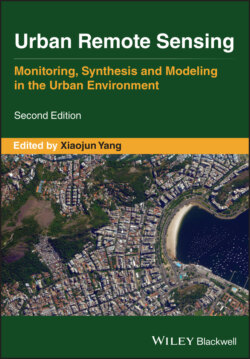Читать книгу Urban Remote Sensing - Группа авторов - Страница 29
2.1 INTRODUCTION
ОглавлениеCharacterizing and quantifying changes in the urban environment are of the utmost importance as the urban population continues to grow on all continents; from 1950 to 2014, population in urban areas increased from 746 million to nearly four billion (United Nations 2014). Urban population growth, corresponding changes within the urban environment (e.g. increasingly built‐up), and the effects these changes have on the environment require new remote sensing data and methodological approaches. Despite tremendous progress in the field of remote sensing over the past several decades (Gutman et al. 2004), Land Cover/Land Use Change (LCLUC) and Earth surface analyses and modeling efforts have, to date, primarily relied on passive remote sensing data and analysis techniques. Specifically, data are commonly satellite imagery provided by the Landsat series and more recently the Sentinel series, and implemented methods are image classification techniques such as pixel‐ (unsupervised and supervised; Masek et al. 2000) and object‐based approaches (Myint et al. 2011), image ratios/indices (Zha et al. 2003), and night‐time light mapping (Small and Elvidge 2013; Zhang and Seto 2013) that only account for two‐dimensional (2D) Earth surface dynamics.
Importantly, however, in urban environments, the vertical dimension is a vital component to comprehensively evaluate Earth surface processes and their influence on environmental characteristics such as temperature (i.e. urban heat island; Imhoff et al. 2010), precipitation (Kaufmann et al. 2007), air circulation and quality (Jacobson et al. 2019), pollution (Stevenazzi et al. 2015), groundwater vulnerability (Stevenazzi et al. 2014, 2017), and more (e.g. biodiversity, Seto et al. 2012). Urban areas can change in the vertical dimension through upward growth (i.e. new buildings) or downward decline (i.e. demolishing buildings). Unfortunately, data availability issues – mainly, lack of adequate light detection and ranging (lidar) or similar data (e.g. altimetry sensors, photogrammetrically derived Three‐Dimensional (3D) information) – have restricted many remote sensing scientists to 2D examinations due to major data gaps in temporal data records (annual to decadal) and in spatial coverage (regional to global). In addition, other potential 3D data sources, e.g. radio detection and ranging (radar) data of a variety of types and from several satellite platforms, have undergone limited testing for use in urban remote sensing though with promising results (e.g. Gamba and Houshmand 2002; Sportouche et al. 2011; Nghiem et al. 2017; Nguyen et al. 2018; Mathews et al. 2019).
This chapter provides an overview of 3D geospatial data and methodologies for examination of built‐up volume (primarily, buildings) in the urban environment specifically emphasizing lidar‐ and radar‐based approaches. The sections that follow provide background on 3D data sources, delve more deeply into lidar data and methodologies including a brief case study, an equivalent section for radar data and methods, an outlook section discussing future advancements and challenges, and concluding remarks.
